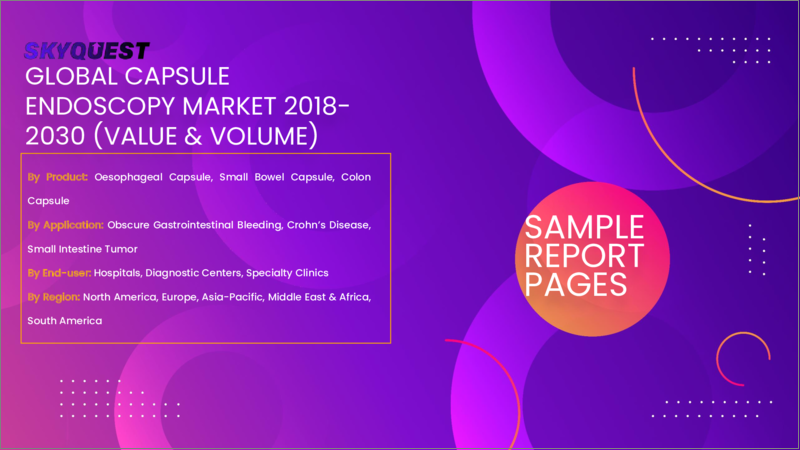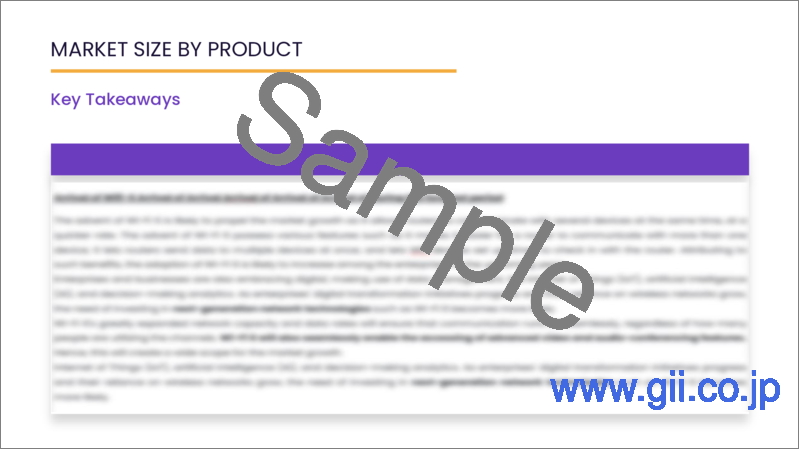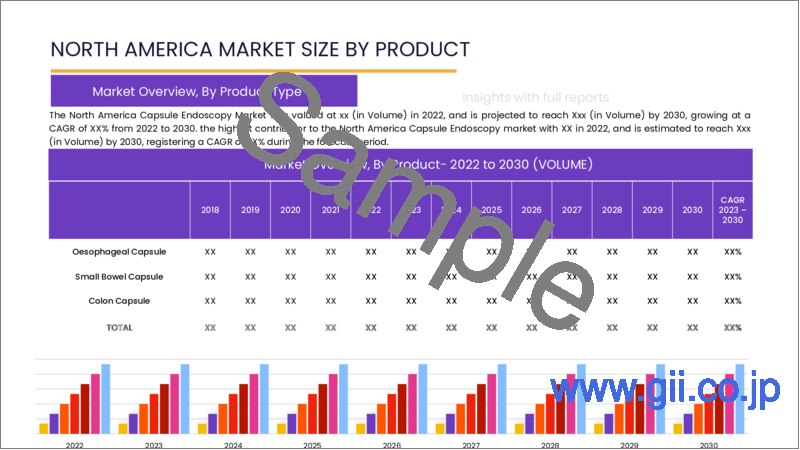|
|
市場調査レポート
商品コード
1260023
カプセル内視鏡の世界市場 (2022-2028年):製品・用途・エンドユーザー別の規模・シェア・成長分析・予測Global Capsule Endoscopy Market Size, Share, Growth Analysis, By Product, By Application, By End User - Industry Forecast 2022-2028 |
||||||
| カプセル内視鏡の世界市場 (2022-2028年):製品・用途・エンドユーザー別の規模・シェア・成長分析・予測 |
|
出版日: 2022年12月11日
発行: SkyQuest
ページ情報: 英文 165 Pages
納期: 3~5営業日
|
- 全表示
- 概要
- 目次
世界のカプセル内視鏡の市場規模は、2021年の4億6,550万米ドルから、予測期間中は8.7%のCAGRで推移し、2028年には8億5,562万米ドルの規模に成長すると予測されています。
OGIB (Obscure GI Tract Bleeding) 、クローン病、癌、小腸腫瘍などの消化器疾患の診断に用いられる低侵襲外科手術の増加により、内視鏡装置や電子カプセルの需要も高まっています。内視鏡は、このような消化器系疾患のスクリーニングに極めて迅速かつ効果的な所見を提供し、市場の成長に拍車をかけています。また、ハイブリッドイメージング技術の開発、カプセル内視鏡技術の向上、高度な診断を患者が好む傾向なども同市場の成長に拍車をかけています。
当レポートでは、世界のカプセル内視鏡の市場を調査し、市場概要、市場への各種影響因子の分析、技術・イノベーションの動向、市場規模の推移・予測、各種区分・地域別の内訳、競合情勢、主要企業のプロファイルなどをまとめています。
目次
エグゼクティブサマリー
親市場の分析
- 市場概要
- 市場規模
- 市場力学
- 促進要因
- 機会
- 抑制要因
- 課題
- 主要市場洞察
- 技術分析
- 価格分析
- サプライチェーン分析
- バリューチェーン分析
- 市場のエコシステム
- IP分析
- 貿易分析
- スタートアップ分析
- 原材料分析
- イノベーションマトリックス
- パイプライン製品分析
- マクロ経済指標
- 主要投資分析
- 主な成功要因
- 競合の程度
- 市場力学と展望
- 市場力学
- 促進要因
- 機会
- 抑制要因
- 課題
- 規制状況
- ポーターの分析
- 将来のディスラプションに関するSkyquestの特別な洞察
- 世界のカプセル内視鏡市場:製品別
- 市場概要
- 食道カプセル
- 小腸カプセル
- 結腸カプセル
世界のカプセル内視鏡市場:用途別
- 市場概要
- 原因不明の消化管出血
- クローン病
- 小腸腫瘍
- 世界のカプセル内視鏡市場:エンドユーザー別
- 市場概要
- 病院
- 診断ラボ
- 専門クリニック
- 世界のカプセル内視鏡市場:地域別
- 市場概要
- 北米
- 欧州
- アジア太平洋
- ラテンアメリカ
- 中東・アフリカ
- 競合情勢
- 主要5社の比較
- 主要企業の市場ポジショニング
- 主要企業の採用戦略
- 主要成功戦略
- 市場における最近の活動
- 主要企業の市場シェア
- 主な企業プロファイル
- Olympus Corporation
- CapsoVision Inc.
- Chongqing Jinshan Science and Technology Group Co.
- IntroMedic Co.
- RF Systems Lab
- Shangxian Minimal Invasive Inc.
- MEDTRONIC PLC.
- Fujifilm Holding Corporation
- Check Cap
- AnX Robotica
Capsule Endoscopy Market was valued at USD 465.5 million in 2021, and the market size is estimated to reach USD 855.62 million by 2028, at a CAGR of 8.7% over the forecast period (2022-2028).
Modern endoscopy is rapid, produces high-quality images, and carries little hazards, making it very beneficial in many medical specialties. Endoscopies are performed on tens of millions of people each year. One of the major factors driving the growth of the global capsule endoscopy market is the rise in a number of chronic diseases, including as cancer and gastrointestinal disorders, in both developed and developing countries.
Due to the rise in the use of minimally invasive surgical procedures, which are primarily used to diagnose gastrointestinal disorders like OGIB (Obscure GI Tract Bleeding), crohn's disease, cancer, and small intestine tumours, the demand for endoscopic devices and electronic capsules has also increased. Endoscopes are medical instruments that need just minor bodily penetration, such as the mouth or anus. This endoscopy offers exceptionally quick and effective findings for screening such gastrointestinal problems, spurring market growth. For instance, according to the CDC, 14.8 million Americans suffer from ulcers. About 5.9% of all adult patients with ulcers have digestive system diseases as their primary diagnosis when they go to the doctor.
Also, in 2020, there were roughly 2.5 million cases of inflammatory bowel disease in the United States. About 3.5 million Americans are expected to have IBD by the year 2030. Due to the rise in digestive diseases, there is a greater need for minimally invasive therapies, which has sped up the development of the capsule endoscopy market.
The growth of the worldwide capsule endoscopy market is also being fueled by the creation of hybrid imaging techniques, improvements in capsule endoscopy technology, and a rise in patient preference for advanced diagnostics.
Top-down and bottom-up approaches were used to estimate and validate the size of Asia Pacific Capsule Endoscopy Market and to estimate the size of various other dependent submarkets. The research methodology used to estimate the market size includes the following details: The key players in the market were identified through secondary research, and their market shares in the respective regions were determined through primary and secondary research. This entire procedure includes the study of the annual and financial reports of the top market players and extensive interviews for key insights from industry leaders such as CEOs, VPs, directors, and marketing executives. All percentage shares split, and breakdowns were determined by using secondary sources and verified through Primary sources. All possible parameters that affect the markets covered in this research study have been accounted for, viewed in extensive detail, verified through primary research, and analyzed to get the final quantitative and qualitative data.
Segments covered in this report:
The global capsule endoscopy market is segmented based on product, application, end user, and region. Based on product, the capsule endoscopy market is segmented into capsule endoscopes and systems. Based on application, the capsule endoscopy market is segmented into obscure gastrointestinal bleeding, Crohn's disease, small intestine tumor. Based on end user, the capsule endoscopy market is segmented into hospitals, diagnostic laboratories, specialty clinics. Based on region, the capsule endoscopy market is categorized into North America, Europe, Asia-Pacific, and MEA.
Driver
Technology advancements have broadened the variety of conditions for which capsule endoscopy systems are used, such as colon, small bowel, and esophageal diseases. The diagnostic, monitoring, and viewing capabilities of the conventional endoscope have been improved by technological developments. Modern technology has led to the creation of new types of capsule endoscopes, including those for the oesophagus, colon, and small intestine. A 360-degree panoramic camera that is user-friendly and has great resolution is also being developed by product manufacturers. Because to developments, endoscopy now offers a high level of accuracy, safety, and precision that would have been challenging to achieve just a few years ago. The fiberoptic endoscope (fiberscope) has lately been supplanted by the video scope and the capsule endoscope. The PillCam Small Bowel 3 system for remote endoscopic operations will also be available in November 2021. The PillCam SB3 @HOME programme, which makes use of Amazon logistics and Medtronic's PillCam technology, promises to provide patients with access to quick, accurate results from the comfort of their own homes. The small bowel can be seen and monitored directly with the help of PillCam SB3 @HOME, a telemedicine alternative. It can help uncover lesions that upper and lower endoscopy miss, and it may also disclose the causes of iron deficiency anaemia, indicate Crohn's disease, or find hidden bleeding (IDA).
Restraint
Several of its restrictions, such as capsule retention and usage limited to diagnostic purposes, prevent the commercial spread of capsule endoscopy. To lessen the likelihood of capsule retention, endoscopic retrieval or surgical excision may be required. For instance, a research published in Annals of Translational Medicine discovered that capsule retention occurred in roughly 2% of patients following small intestinal endoscopic surgery. Because of this, using capsule endoscopes is challenging. Also, due to the quick transit of the capsule and the fuzzy, unintelligible images, issues in some regions of the intestine are overlooked. Food or faeces residue could distort images. Retention of the small bowel device during capsule endoscopy is the greatest risk. Between one and two percent of patients who get the test to look for bleeding run a very low risk of bleeding. There may be a four to five percent risk increase for patients with Crohn's disease. However, it is anticipated that as technology advances and wireless capsules get better, the retention rate will fall, which would encourage the growth of the capsule endoscopy market.
Market Trends
Medical conditions include gastrointestinal disorders, inflammatory bowel diseases, and colon cancer have rapidly increased in prevalence over the past several years as a result of a range of environmental variables as well as changes in people's general lives. The prevalence of colorectal cancer is increasing on a global scale. Colorectal cancer is the third most common cancer to be diagnosed and the second most common condition that results in mortality. Screening and more knowledge can drastically lower the fatality rate associated with colorectal cancer. Also, as people age, GI issues including appendicitis, inflammatory bowel disease, and CRC become more likely to occur; for this reason, screening is essential to stop complications and the future development of GI illnesses. The National Colorectal Round Table estimates that screening beginning at age 50 can stop 230,000 deaths from colorectal cancer. It is anticipated that as these medical conditions become more prevalent, there will be a large increase in the demand for capsule endoscopy. A colonoscopy is the common method for finding colorectal cancer. Yet, the drawbacks of colonoscopy and the growing demand for minimally invasive procedures have led to a rise in the usage of capsule endoscopy. Capsule endoscopy, a non-invasive wireless diagnostic method, provides medical professionals with a comprehensive view of the small intestine. Technology has fundamentally altered how conditions of the small intestine, such as cancer, inflammatory bowel disease, celiac disease, and unexplained gastrointestinal bleeding, are identified and treated.
Table of Contents
Executive Summary
- Market Overview
- Wheel of Fortune
- Research Methodology
- Information Procurement
- Secondary & Primary Data Sources
- Market Size Estimation
- Market Assumptions & Limitations
Parent Market Analysis
- Market Overview
- Market Size
- Market Dynamics
- Drivers
- Opportunities
- Restraints
- Challenges
- Key Market Insights
- Technology Analysis
- Pricing Analysis
- Supply Chain Analysis
- Value Chain Analysis
- Ecosystem of the Market
- IP Analysis
- Trade Analysis
- Startup Analysis
- Raw Material Analysis
- Innovation Matrix
- Pipeline Product Analysis
- Macroeconomic Indicators
- Top Investment Analysis
- Key Success Factor
- Degree of Competition
- Market Dynamics & Outlook
- Market Dynamics
- Drivers
- Opportunities
- Restraints
- Challenges
- Regulatory Landscape
- Porters Analysis
- Competitive rivalry
- Threat of Substitute Products
- Bargaining Power of Buyers
- Threat of New Entrants
- Bargaining Power of Suppliers
- Skyquest Special Insights on Future Disruptions
- Political Impact
- Economic Impact
- Social Impact
- Technical Impact
- Environmental Impact
- Legal Impact
- Global Capsule Endoscopy Market by Product
- Market Overview
- Oesophageal Capsule
- Small Bowel Capsule
- Colon Capsule
Global Capsule Endoscopy Market by Application
- Market Overview
- Obscure Gastrointestinal Bleeding
- Crohn's Disease
- Small Intestine Tumor
- Global Capsule Endoscopy Market by End User
- Market Overview
- Hospitals
- Diagnostic Laboratories
- Specialty Clinics
- Global Capsule Endoscopy Market Size by Region
- Market Overview
- North America
- USA
- Canada
- Europe
- Germany
- Spain
- France
- UK
- Rest of Europe
- Asia Pacific
- China
- India
- Japan
- South Korea
- Rest of Asia-Pacific
- Latin America
- Brazil
- Rest of Latin America
- Middle East & Africa (MEA)
- GCC Countries
- South Africa
- Rest of MEA
- Competitive Landscape
- Top 5 Player Comparison
- Market Positioning of Key Players, 2021
- Strategies Adopted by Key Market Players
- Top Winning Strategies
- By Development
- By Company
- By Year
- Recent Activities in the Market
- Key Companies Market Share (%), 2021
- Key Company Profiles
- Olympus Corporation (Japan)
- Company Overview
- Business Segment Overview
- Financial Updates
- Key Developments
- CapsoVision Inc. (US)
- Company Overview
- Business Segment Overview
- Financial Updates
- Key Developments
- Chongqing Jinshan Science and Technology Group Co. (China)
- Company Overview
- Business Segment Overview
- Financial Updates
- Key Developments
- IntroMedic Co. (South Korea)
- Company Overview
- Business Segment Overview
- Financial Updates
- Key Developments
- RF Systems Lab (Japan)
- Company Overview
- Business Segment Overview
- Financial Updates
- Key Developments
- Shangxian Minimal Invasive Inc. (China)
- Company Overview
- Business Segment Overview
- Financial Updates
- Key Developments
- MEDTRONIC PLC. (Ireland)
- Company Overview
- Business Segment Overview
- Financial Updates
- Key Developments
- Fujifilm Holding Corporation (Japan)
- Company Overview
- Business Segment Overview
- Financial Updates
- Key Developments
- Check Cap (Israel)
- Company Overview
- Business Segment Overview
- Financial Updates
- Key Developments
- AnX Robotica (US)
- Company Overview
- Business Segment Overview
- Financial Updates
- Key Developments




